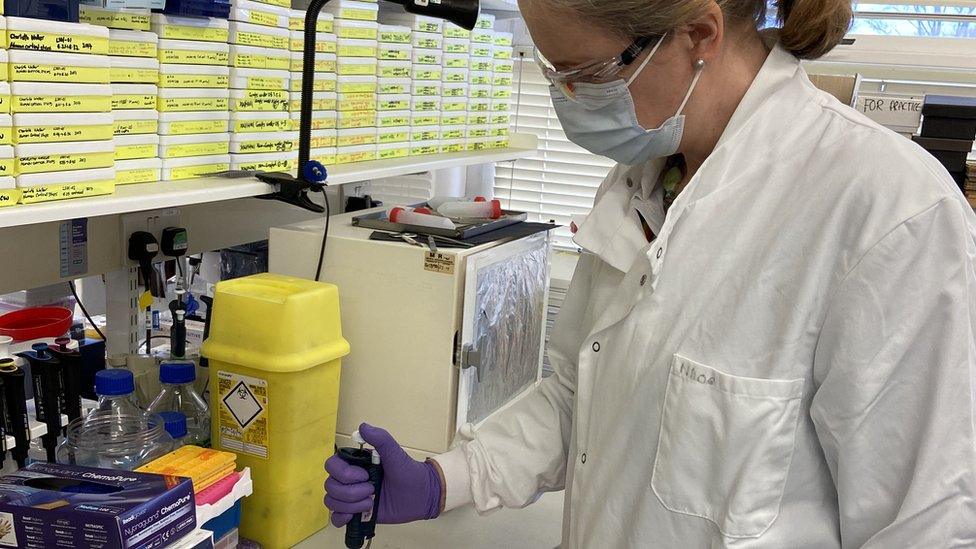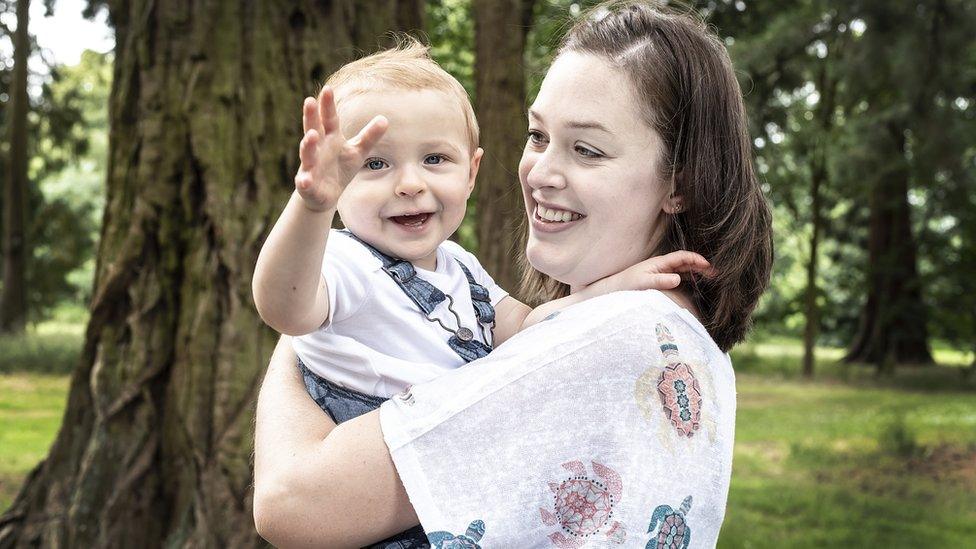Endometriosis: How new treatment 'changed my life'
- Published
Watch: Jessica says she was in constant agony before the trial
Taking the dog for a walk is a routine task for most people. But Jessica Rafferty would often have to cut outings short due to crippling pain.
She, like one in 10 women, lives with endometriosis - a condition where tissue similar to the lining of the womb grows elsewhere inside the body. It can be incredibly painful, and can take years to diagnose.
And there is no known cure.
But Jessica is part of the search for effective treatments. She is among 30 women taking part in the University of Edinburgh study looking at dichloroacetate, a drug currently used to treat rare metabolic conditions in children.
It helps to control lactate levels, which have been found to be higher in patients with some cancers and endometriosis.
Jessica, who's 24, went to hospital about 200 times, with her symptoms initially attributed to IBS and coeliac disease. She even had her appendix removed, before endometriosis was finally discovered to be the underlying cause.
But during the 12-week trial, her symptoms dramatically improved.
"The pain decreased immensely. I was able to go and take the dog out and do six-mile walks - and do things that on a daily basis I would not do, or if I did try and do them I would be in a lot of pain.
"It's definitely changed my life so far, having been on this treatment after so many failed treatments and medications and operations."
Dichloroacetate's key benefit is that, unlike every other drug currently used to treat the condition, it is non-hormonal.
Andrew Horne, professor of gynaecology and reproductive sciences, who is leading the study, says: "Clearly endometriosis affects a young female population many of whom are wanting to try and get pregnant, so they don't want to take hormones; they don't want to take a contraceptive. So this would be a very different approach."

What is endometriosis?
It's where tissue similar to the lining of the womb grows elsewhere inside the body - often around reproductive organs, bowel and bladder
Like the womb lining, tissue builds up every month then bleeds
However, unlike a period, there is no way for the blood to escape
The build-up of trapped blood can result in internal lesions and scar tissue
Some people experience no symptoms but for many others the pain can be debilitating, and the condition can lead to infertility
There is currently no known cause or cure for the condition.

Prof Horne says even though it's too early for any conclusive results on how well the drug works, the findings so far are "exciting". The team is hoping to expand, and receive enough funding for a much larger trial involving up to 400 volunteers.
The work is among a number of research projects offering hope for people with the condition that will be highlighted at the World Congress on Endometriosis., external
Current treatment options are limited to repeated surgeries (including full hysterectomies), hormonal drugs or painkillers such as ibuprofen or paracetomol.
Another study, by experts at the University of Oxford, is seeking to unlock the genetic secrets of the condition.
For the past three years, Prof Krina Zondervan and her team have been analysing tissue samples donated by 60,000 patients with endometriosis around the world. It's the largest study of its kind ever undertaken.
Their soon-to-be published work reveals new details about endometriosis, including confirmation that it is not one single condition. They have also uncovered genetic links to other inflammatory conditions such as asthma and osteoarthritis, and pain conditions such as migraines and back pain.

Prof Krina Zondervan hopes her work will speed up the development of endometriosis treatments
Prof Zondervan says they hope the understanding will mean they can investigate whether drugs currently used for those conditions could be repurposed to treat endometriosis: "And that will really speed up the process of drug discovery."
In simple terms, now that a link has been discovered, a drug used to treat asthma could be tweaked to treat endometriosis. That process would be a lot quicker than building a drug from scratch.
The potential breakthroughs have been welcomed by campaigners, who argue research into the condition has been chronically underfunded.
Emma Cox, CEO of Endometriosis UK, says: "Research is vital, offering hope for those with endometriosis and future generations.
"We need to know so much more to support those living with this chronic disease to manage their sometimes debilitating symptoms, and to one day find a cure".
As promising as this research might prove to be, approval for any new non-hormonal drug treatment is likely to be a few years away.
But for a community which has often felt overlooked, ignored and disbelieved, there is comfort in knowing that potential medical breakthroughs are on the horizon.
Related topics
- Published19 October 2020

- Published18 August 2020
